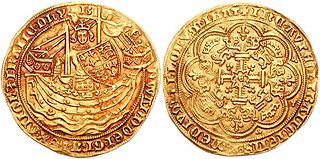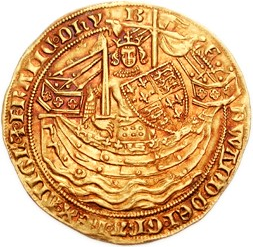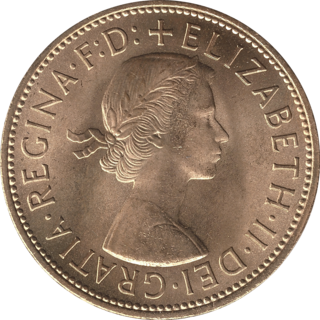
The noble was the first English gold coin produced in quantity, introduced during the second coinage (1344–1346) of King Edward III. It was preceded by the gold penny and the florin, minted during the reign of King Henry III and the beginning of the reign of King Edward III; these saw little circulation. The derivatives of the noble, the half noble and quarter noble, on the other hand, were produced in quantity and were very popular.

The history of the English penny from 1603 to 1707 covers the period of the House of Stuart, up to the Acts of Union of 1707 which brought about the Union of the Kingdom of England with the Kingdom of Scotland.

The British florin, or two-shilling coin, was issued from 1849 until 1967, with a final issue for collectors dated 1970. Equivalent in value to one-tenth of a pound, it was the last coin circulating immediately prior to decimalisation to be demonetised, in 1993, having for a quarter of a century circulated alongside the ten-pence piece, identical in specifications and value.

The British threepence (3d) coin, usually simply known as a threepence, thruppence, or thruppenny bit, was a unit of currency equalling one eightieth of a pound sterling, or three old pence sterling. It was used in the United Kingdom, and earlier in Great Britain and England. Similar denominations were later used throughout the British Empire and Commonwealth countries, notably in Australia, New Zealand and South Africa.
The Spur Royal was an extremely rare English gold coin issued in the reign of King James I. The coin is a development of the earlier Rose Noble, or Ryal which was worth ten shillings when issued by Kings Edward IV and Henry VII, and fifteen shillings when issued by Queens Mary and Elizabeth I.

The Triple Unite, valued at sixty shillings, 60/- or three pounds, was the highest English denomination to be produced in the era of the hammered coinage. It was only produced during the English Civil War, at King Charles I's mints at Oxford and, rarely, at Shrewsbury in 1642. It weighed 421 grains.
The Five Guinea was a machine-struck gold coin produced from 1668–1753. Measuring 37 millimetres in diameter and weighing between 41 and 42 grams, it was the largest regularly produced gold coin in Britain. Although the coin is commonly known as the "Five guinea" piece, during the 17th and 18th centuries it was also known as a Five-pound piece, as the guinea was originally worth twenty shillings — until its value was fixed at twenty-one shillings by a Royal Proclamation in 1717 the value fluctuated rather in the way that bullion coins do today.
The five pounds gold coin is a British coin, produced in several periods since the early 19th century. Since 1990 it is also known as the five-sovereign piece or quintuple sovereign as it is equivalent to five sovereign coins and shares the alloy and design features of the sovereign.

The Two Guineas was a gold coin first minted in England in 1664 with a face value of forty shillings. The source of the gold used, also provided the coin its name - the "Guinea", with the regular addition of an elephant or castle symbol on the earliest issues to denote bullion supplied by the Royal African Company. For most of its period of production, the coin weighed between 16.7 and 16.8 grams and was 31-32 millimetres in diameter, although the earliest coins of Charles II were about 0.1 grams lighter and 1 millimetre smaller.

The guinea was a coin, minted in Great Britain between 1663 and 1814, that contained approximately one-quarter of an ounce of gold. The name came from the Guinea region in West Africa, from where much of the gold used to make the coins was sourced. It was the first English machine-struck gold coin, originally worth one pound sterling, equal to twenty shillings, but rises in the price of gold relative to silver caused the value of the guinea to increase, at times to as high as thirty shillings. From 1717 to 1816, its value was officially fixed at twenty-one shillings.

The Quarter guinea was a British coin minted only in the years 1718 and 1762. As the name implies, it was valued at one-fourth of a guinea, which at that time was worth twenty-one shillings. The quarter guinea therefore was valued at five shillings and threepence.
The half guinea gold coin of the Kingdom of England and later of Great Britain was first produced in 1669, some years after the Guinea entered circulation. It was officially eliminated in the Great Recoinage of 1816, although, like the guinea, it was used in quoting prices until decimalisation.
The Laurel was the third English gold coin with a value of twenty shillings or one pound produced during the reign of King James I. It was named after the laurel that the king is portrayed as wearing on his head, but it is considerably poorer in both quality and style than the sovereign and unite which preceded it. The coin was produced during James I's third coinage (1619-1625), five different busts of the king being used in these years. All the coins were produced at the Tower Mint in London. The laurel weighed 140.5 grains, less than the previous Unite but almost exactly the same as the Unite issued under Charles I.

The half laurel was a coin of the Kingdom of England minted between 1619 and 1625, with a value of ten shillings.

The Rose Ryal is a gold coin of the Kingdom of England issued in the reign of King James I and is now very rare. The coin is really a two-ryal coin worth thirty shillings and is a development of the earlier fine sovereign of Queen Elizabeth I.

The half sovereign is an English and later, British gold coin with a nominal value of half a pound sterling, or ten shillings. It is half the weight of its counterpart 'full' sovereign coin.
The threepence or threepenny bit was a denomination of currency used by various jurisdictions in England, Ireland, Scotland and Wales, valued at 1/80 of a pound or ¼ of a shilling until decimalisation of the pound sterling and Irish pound in 1971. It was also used in some parts of the British Empire, notably Australia, New Zealand and South Africa.

The pre-decimal penny (1d) was a coin worth 1⁄240 of a pound sterling, or 1⁄12 of a shilling. Its symbol was d, from the Roman denarius. It was a continuation of the earlier English penny, and in Scotland it had the same monetary value as one pre-1707 Scottish shilling. The penny was originally minted in silver, but from the late 18th century it was minted in copper, and then after 1860 in bronze.
The English shilling was a silver coin of the Kingdom of England, when first introduced known as the testoon. It remained in circulation until it became the British shilling as the result of the Union of England and Scotland to form the Kingdom of Great Britain in 1707.

The double sovereign is a gold coin of the United Kingdom, with a nominal value of two pounds sterling or 40 shillings.














